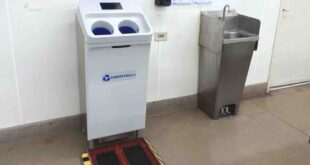In light of the 2019 power outage incident in the UK and the continuous advancements in battery technology, such as the development of iron-based batteries, the Stephen Hayes explores the integration of sophisticated control algorithms and automation technology. These advancements are pivotal in enhancing grid stability and ensuring a consistent energy supply during periods of low renewable generation. He dives into the crucial role of control technology in maximising the efficiency and reliability of energy storage systems (ESS) amid the fluctuating nature of renewable energy sources
With the intermittent nature of renewable sources, like solar and wind power, the ability to store excess energy during peak production periods and release it when demand is high is needed to ensure grid stability and reliability. This is where advancements in energy storage technology, such as Form Energy’s iron-based batteries, holds great promise.
Form Energy is working on developing a new type of battery technology that is specifically designed for storing renewable energy for extended periods. Here, the aim is to store energy for days or even weeks, with these batteries providing a reliable power source during periods of low renewable energy generation, such as cloudy days or calm nights.
Unlike traditional lithium-ion batteries, Form Energy’s iron-air battery system relies on cheap and abundant materials, making it potentially more cost-effective and scalable. Although this technology could transform the way renewable energy is stored and used, the role control automation plays in optimising energy storage systems must not be overlooked.
Charging and discharging ESSs
By implementing sophisticated control algorithms, the charging and discharging of Energy Storage Systems (ESSs) can be optimised to align with the fluctuating nature of renewable energy sources.
Ultimately, this ensures that the ESS is charged during periods of excess renewable energy generation and discharged during periods of high demand, thereby maximising the use of stored energy.
In fact, an ESSs charging-discharging strategy proposed a smart strategy for managing the charging and discharging of ESSs in response to changes in solar energy output and evening peak loads.
The research delves into a sophisticated strategy that considers the State of Charge (SoC) of the ESS, which assesses the amount of energy currently stored in the batteries, along with the expected duration of charging and discharging cycles. This strategy ensures that the ESS is used optimally, aligning its operations with the fluctuating outputs of solar panels and the varying energy demands throughout the day.
What’s particularly impressive is that this optimisation process is conducted on an hourly basis. As a result, precise adjustments can be made to minimise energy losses in the distribution system and mitigate the intermittent nature of photovoltaic (PV) based Distributed Generation (DG) outputs.
Crucially, this is achieved because of a genetic algorithm (GA) that factors in energy demand, renewable energy patterns and system constraints. Not only does this aid grid stability but it also promotes sustainable energy systems too, offering potential for ESS applications like voltage support, peak shifting, regulation and increased reliability.
Distributed generation
As well as ensuring storage devices are charged when there is excess renewable generation and discharged when there’s a deficit, control technology is also needed for active network management (ANM).
ANM operates by continuously monitoring critical electrical parameters at specific locations within the network. Deployed in power distribution grids, its primary function is to regulate flexible demand and renewable energy generation to maintain grid stability. However, DG adds another layer of complexity to grid management.
Just look at the power outage incident on August 2019, in the UK, which highlighted various shortcomings in the electricity system’s management and operational readiness. Although the incident was triggered by a lightning strike, its impact was worsened by failures in managing DG and responding to system disturbances effectively.
DG introduces decentralised generation points, like solar panels and wind turbines, that are often interconnected with the grid at various voltage levels. In turn, grid operators need to monitor and manage a larger number of connection points.
After all, in the UK Energy Research Centre’s report about the 2019 power outrage, co-director Keith Bell observed that “it was concerned by the ways in which resources are controlled and the system is operated.”
One way plant managers can tackle the issues presented by DG, along with getting the most out of their energy storage systems, is by implementing advanced control and automation technologies.
For example, ee technik GmbH, a German company specialising in wind farm infrastructure design, uses Beckhoff’s control technology to facilitate grid integration of renewable power. As a result, ee technik can manage network fluctuations effectively, ensuring grid stability amidst varying renewable energy outputs.
Control technology, and that of Form Energy’s iron-based batteries, are both crucial in ensuring the reliability and effectiveness of renewable energy systems. Together, energy is not only stored for extended periods but is also optimised to manage grid stability effectively too, helping to provide power even during the darkest days.
Stephen Hayes is managing director of automation and control technology specialist, Beckhoff UK.
 Engineer News Network The ultimate online news and information resource for today’s engineer
Engineer News Network The ultimate online news and information resource for today’s engineer



